The Mechanical Properties and Microstructural Characterization of Copper Tailing Backfill Cemented with a Slag-Based Material
Abstract
1. Introduction
2. Materials and Experimental Method
2.1. Material Characterization
2.2. Sample Preparation and Loading Procedures
2.2.1. Sample Manufacturing/Curing
2.2.2. Mechanical Test
2.2.3. Scanning Electron Microscopy (SEM) Test
3. Results and Discussion
3.1. Technical Parameter Optimization
3.2. Strength Characteristics of CTB
3.3. Behavior of Stress–Strain Curves
3.4. Failure Mode
3.5. Microanalysis of Enhancement Mechanism of UCS
- (a)
- General characteristics of CTB microstructure
- (b)
- Influence of TCR
- (c)
- Influence of solid content
- (d)
- Influence of curing age
4. Conclusions
Author Contributions
Funding
Data Availability Statement
Conflicts of Interest
Abbreviations
| Cementitious powder | CP |
| Solid content | SC |
| Tailing-to-cement ratio | TCR |
| Curing age | CA |
| Cemented tailing backfill | CTB |
| Ordinary Portland cement | OPC |
| Grain size distribution | GSD |
| Full tailings | FT |
References
- Cao, S.; Yilmaz, E.; Song, W. Fiber type effect on strength, toughness and microstructure of early age cemented tailings backfill. Constr. Build. Mater. 2019, 223, 44–54. [Google Scholar] [CrossRef]
- Chen, S.; Yilmaz, E.; Wang, W.; Wang, Y. Curing stress effect on stability, microstructure, matric suction and electrical conductivity of cementitious tailings backfills. Constr. Build. Mater. 2022, 360, 129601. [Google Scholar] [CrossRef]
- Zhao, Y.; Taheri, A.; Karakus, M.; Chen, Z.; Deng, A. Effects of water content, water type and temperature on the rheological be-haviour of slag-cement and fly ash-cement paste backfill. Int. J. Min. Sci. Technol. 2020, 30, 271–278. [Google Scholar] [CrossRef]
- Guo, H.; Sun, Q.; Feng, G.; Li, S.; Xiao, Y. In-situ observations of damage-fracture evolution in surrounding rock upon unloading in 2400-m-deep tunnels. Int. J. Min. Sci. Technol. 2023, 33, 437–446. [Google Scholar] [CrossRef]
- Wang, S.; Song, X.; Wei, M.; Liu, W.; Tao, T. Strength characteristics and microstructure evolution of cemented tailings backfill with rice straw ash as an alternative binder. Constr. Build. Mater. 2021, 297, 123780. [Google Scholar] [CrossRef]
- Hou, Y.; Yin, S.; Chen, X.; Zhang, M.; Yang, S. Study on characteristic stress and energy damage evolution mechanism of cemented tailings backfill under uniaxial compression. Constr. Build. Mater. 2021, 301, 124333. [Google Scholar] [CrossRef]
- Chen, S.; Yilmaz, E.; Xiang, Z.; Wang, Y. Curing conditions effect on pore structure, compressive strength and elastic modulus of cementitious tailings backfills. Powder Technol. 2023, 422, 118458. [Google Scholar] [CrossRef]
- Edraki, M.; Baumgartl, T.; Manlapig, E.; Bradshaw, D.; Franks, D.M.; Moran, C.J. Designing mine tailings for better environmental, social and economic outcomes: A review of alternative approaches. J. Clean. Prod. 2014, 84, 411–420. [Google Scholar] [CrossRef]
- Yang, L.; Yilmaz, E.; Li, J.; Liu, H.; Jiang, H. Effect of superplasticizer type and dosage on fluidity and strength behavior of cemented tailings backfill with different solid contents. Constr. Build. Mater. 2018, 187, 290–298. [Google Scholar] [CrossRef]
- Wang, J.; Fu, J.; Song, W.; Zhang, Y. Effect of rice husk ash (RHA) dosage on pore structural and mechanical properties of cemented paste backfill. J. Mater. Res. Technol. 2022, 17, 840–851. [Google Scholar] [CrossRef]
- Eker, H.; Bascetin, A. Influence of silica fume on mechanical property of cemented paste backfill. Constr. Build. Mater. 2022, 317, 126089. [Google Scholar] [CrossRef]
- Gao, R.; Zhou, K.; Zhou, Y.; Yang, C. Research on the fluid characteristics of cemented backfill pipeline transportation of mineral processing tailings. Alexandria Eng. J. 2020, 59, 4409–4426. [Google Scholar] [CrossRef]
- Lu, H.; Qi, C.; Chen, Q.; Gan, D.; Xue, Z.; Hu, Y. A new procedure for recycling waste tailings as cemented paste backfill to underground stopes and open pits. J. Clean. Prod. 2018, 188, 601–612. [Google Scholar] [CrossRef]
- Sun, W.; Wang, H.; Hou, K. Control of waste rock-tailings paste backfill for active mining subsidence areas. J. Clean. Prod. 2018, 171, 567–579. [Google Scholar] [CrossRef]
- Zhao, K.; Huang, M.; Zhou, Y.; Yan, Y.; Wan, W.; Ning, F.; He, Z.; Wang, J. Synergistic deformation in a combination of cemented paste backfill and rocks. Constr. Build. Mater. 2022, 317, 125943. [Google Scholar] [CrossRef]
- Song, X.; Hao, Y.; Wang, S.; Zhang, L.; Liu, W.; Li, J. Mechanical properties, crack evolution and damage characteristics of prefabricated fractured cemented paste backfill under uniaxial compression. Constr. Build. Mater. 2022, 330, 127251. [Google Scholar] [CrossRef]
- He, X.; Li, W.; Yang, J.; Su, Y.; Zhang, Y.; Zeng, J.; Dai, F.; Tan, H. Multi-solid waste collaborative production of clinker-free cemented iron tailings backfill material with ultra-low binder-tailing ratio. Constr. Build. Mater. 2023, 367, 130271. [Google Scholar] [CrossRef]
- Fall, M.; Célestin, J.C.; Pokharel, M.; Touré, M. A contribution to understanding the effects of curing temperature on the mechanical properties of mine cemented tailings backfill. Eng. Geol. 2010, 114, 397–413. [Google Scholar] [CrossRef]
- Xu, W.; Li, Q.; Liu, B. Coupled effect of curing temperature and age on compressive behavior, microstructure and ultrasonic properties of cemented tailings backfill. Constr. Build. Mater. 2020, 237, 117738. [Google Scholar] [CrossRef]
- Yilmaz, E.; Belem, T.; Benzaazoua, M. Effects of curing and stress conditions on hydromechanical, geotechnical and geochemical properties of cemented paste backfill. Eng. Geol. 2014, 168, 23–37. [Google Scholar] [CrossRef]
- Ercikdi, B.; Kesimal, A.; Cihangir, F.; Deveci, H.; Alp, İ. Cemented paste backfill of sulphide-rich tailings: Importance of binder type and dosage. Cem. Concr. Compos. 2009, 31, 268–274. [Google Scholar] [CrossRef]
- Guo, Z.; Qiu, J.; Jiang, H.; Zhang, S.; Ding, H. Improving the performance of superfine-tailings cemented paste backfill with a new blended binder. Powder Technol. 2021, 394, 149–160. [Google Scholar] [CrossRef]
- Fall, M.; Benzaazoua, M. Modeling the effect of sulphate on strength development of paste backfill and binder mixture optimi-zation. Cem. Concr. Res. 2005, 35, 301–314. [Google Scholar] [CrossRef]
- Qi, C.; Fourie, A. Cemented paste backfill for mineral tailings management: Review and future perspectives. Miner. Eng. 2019, 144, 106025. [Google Scholar] [CrossRef]
- Chen, M.; Ma, M.; Lin, Y.; Ma, Z.; Li, K. Carbon Kuznets curve in China’s building operations: Retrospective and prospective tra-jectories. Sci. Total Environ. 2022, 803, 150104. [Google Scholar] [CrossRef]
- Zhao, K.; Zhou, Y.; Huang, Q.; Yin, S.H.; Yan, Y.; Wu, J.; Shen, L.; Zeng, X. Early properties and modeling of cemented superfine tailings backfill containing sodium dodecyl sulfate: Microstructure, mechanics, and acoustics. Mech. Mater. 2023, 179, 104567. [Google Scholar] [CrossRef]
- Yin, S.; Yan, Z.; Chen, X.; Wang, L. Effect of fly-ash as fine aggregate on the workability and mechanical properties of cemented paste backfill. Case Stud. Constr. Mater. 2022, 16, e01039. [Google Scholar] [CrossRef]
- Ercikdi, B.; Cihangir, F.; Kesimal, A.; Deveci, H.; Alp, I. Utilization of industrial waste products as pozzolanic material in cemented paste backfill of high sulphide mill tailings. J. Hazard. Mater. 2009, 168, 848–856. [Google Scholar] [CrossRef]
- Serge, O.; Bruno, B.; Michel, A.; Mostafa, B. Microstructural evolution of cemented paste backfill: Mercury intrusion porosimetry test results. Cem. Concr. Res. 2007, 37, 1654–1665. [Google Scholar] [CrossRef]
- Xu, W.; Zhang, Y.; Liu, B. Influence of silica fume and low curing temperature on mechanical property of cemented paste backfill. Constr. Build. Mater. 2020, 254, 119305. [Google Scholar] [CrossRef]
- Yan, B.; Tannant, D.D.; Ren, F.; Cai, M.F. Effects of Silica Fume on the Performance of Cemented Paste Backfill Mixed with Brine. Geotech. Geol. Eng. 2019, 37, 4575–4587. [Google Scholar] [CrossRef]
- Sun, Q.; Li, T.; Liang, B. Preparation of a New Type of Cemented Paste Backfill with an Alkali-Activated Silica Fume and Slag Composite Binder. Materials 2020, 13, 372. [Google Scholar] [CrossRef] [PubMed]
- Chen, C.; Li, X.; Chen, X.; Chai, J.; Tian, H. Development of cemented paste backfill based on the addition of three mineral additions using the mixture design modeling approach. Constr. Build. Mater. 2019, 229, 116919. [Google Scholar] [CrossRef]
- David, O.K.; Chen, C.T. Strength development of lime-pozzolana pastes with silica fume and fly ash. Constr. Build. Mater. 2015, 84, 294–300. [Google Scholar]
- Zhang, N.; Ahmadreza, H.; Héctor, G.B.S.; Roberto, P.H.B.; Néstor, T.; Isaac, Y.M.; Reynaldo, S.C.L. On the incorporation of class F fly-ash to enhance the geopolymerization effects and splitting tensile strength of the gold mine tailings-based geopolymer. Constr. Build. Mater. 2021, 308, 125112. [Google Scholar] [CrossRef]
- Sari, M.; Yilmaz, E.; Kasap, T.; Guner, N.U. Strength and microstructure evolution in cemented mine backfill with low and high pH pyritic tailings: Effect of mineral admixtures. Constr. Build. Mater. 2022, 328, 127109. [Google Scholar] [CrossRef]
- Zhang, F.; Li, Y.; Zhang, J.; Gui, X.; Zhu, X.; Zhao, C. Effects of slag-based cementitious material on the mechanical behavior and heavy metal immobilization of mine tailings based cemented paste backfill. Heliyon 2022, 8, e10695. [Google Scholar] [CrossRef]
- Jiang, H.; Qi, Z.; Yilmaz, E.; Han, J.; Qiu, J.; Dong, C. Effectiveness of alkali-activated slag as alternative binder on workability and early age compressive strength of cemented paste backfills. Constr. Build. Mater. 2019, 218, 689–700. [Google Scholar] [CrossRef]
- Xue, G.; Yilmaz, E.; Song, W.; Cao, S. Compressive Strength Characteristics of Cemented Tailings Backfill with Alkali-Activated slag. Appl. Sci. 2018, 8, 1537. [Google Scholar] [CrossRef]
- McCarthy, D.F. Essentials of Soil Mechanics and Foundations: Basic Geotechnics, 7th ed.; Pearson Prentice Hall: Toronto, ON, Canada, 2017. [Google Scholar]
- Li, R.; Zhao, L.; Wang, W.; Liu, C.; Wang, X. Standard Test Methods for Basic Properties of Building Mortars, 1st ed.; China Construction Industry Press: Beijing, China, 2009; pp. 1–69. [Google Scholar]
- Zhang, S.; Zhao, Y.; Ding, H.; Qiu, J.; Hou, C. Effect of sodium chloride concentration and pre-curing time on the properties of ce-mented paste backfill in a sub-zero environment. J. Clean. Prod. 2020, 283, 125310. [Google Scholar] [CrossRef]
- Chen, X.; Wu, S. Influence of water-to-cement ratio and curing period on pore structure of cement mortar. Constr. Build. Mater. 2013, 38, 804–812. [Google Scholar] [CrossRef]
- Zhao, Z.; Guo, K.; Wang, X. A binder prepared by low-reactivity blast furnace slags for cemented paste backfill: Influence of su-per-fine fly ash and chemical additives. Constr. Build. Mater. 2022, 327, 126988. [Google Scholar] [CrossRef]
- Chen, X.; Shia, X.; Zhou, J.; Du, X.; Chen, Q.; Qiu, X. Effect of overflow tailings properties on cemented paste backfill. J. Environ. Manage. 2019, 235, 133–144. [Google Scholar] [CrossRef]
- Zhang, S.; Zhao, Y.; Guo, Z.; Ding, H. Stabilization/solidification of hexavalent chromium containing tailings using low-carbon binders for cemented paste backfill. J. Environ. Chem. Eng. 2020, 9, 104738. [Google Scholar] [CrossRef]
- Tugrul, K.; Erol, Y.; Muhammet, S. Effects of mineral additives and age on microstructure evolution and durability properties of sand-reinforced cementitious mine backfills. Constr. Build. Mater. 2022, 352, 129079. [Google Scholar] [CrossRef]

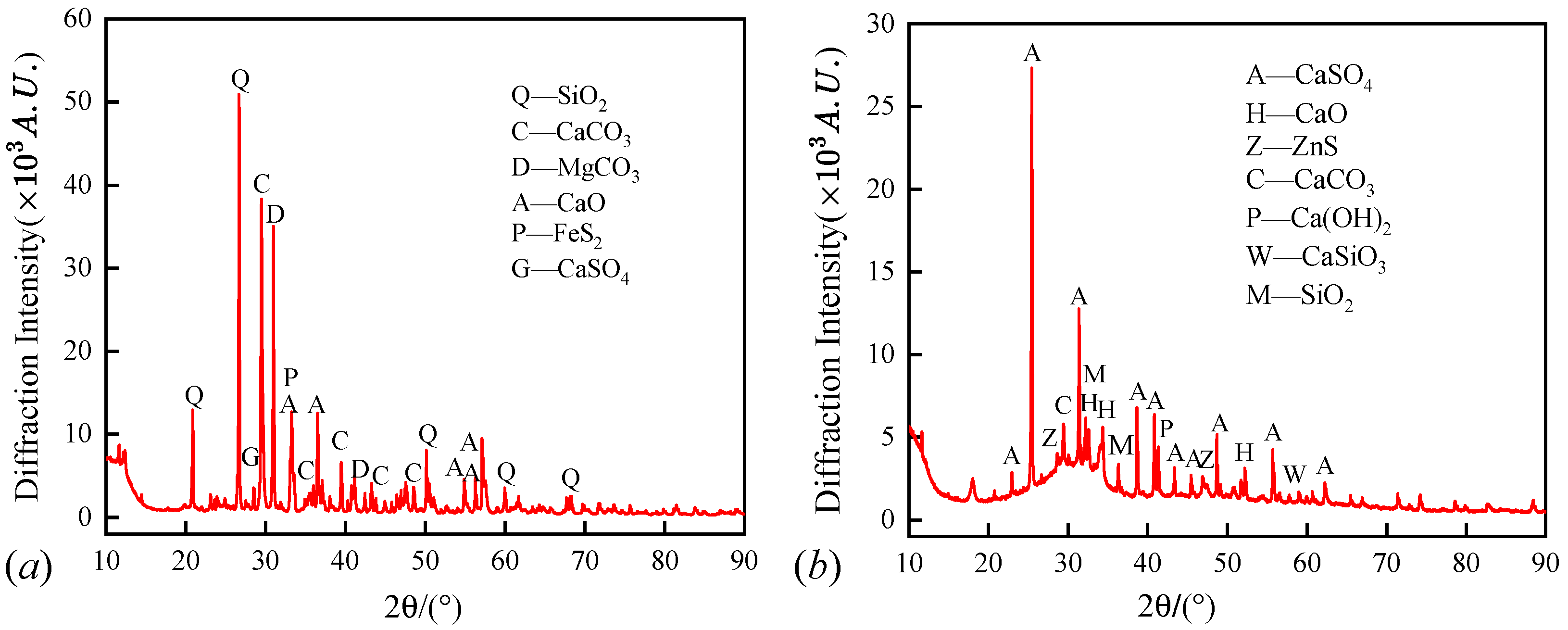





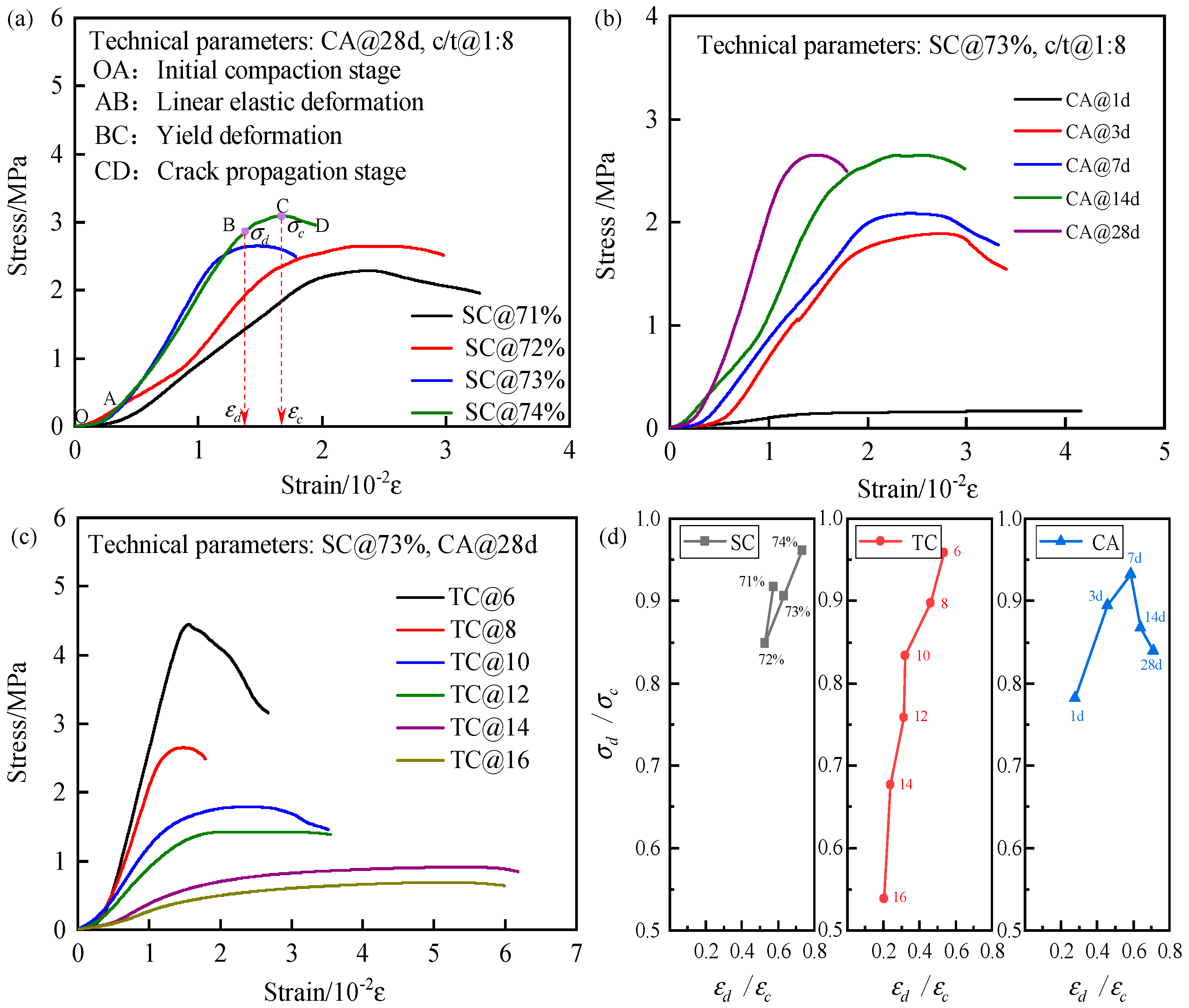
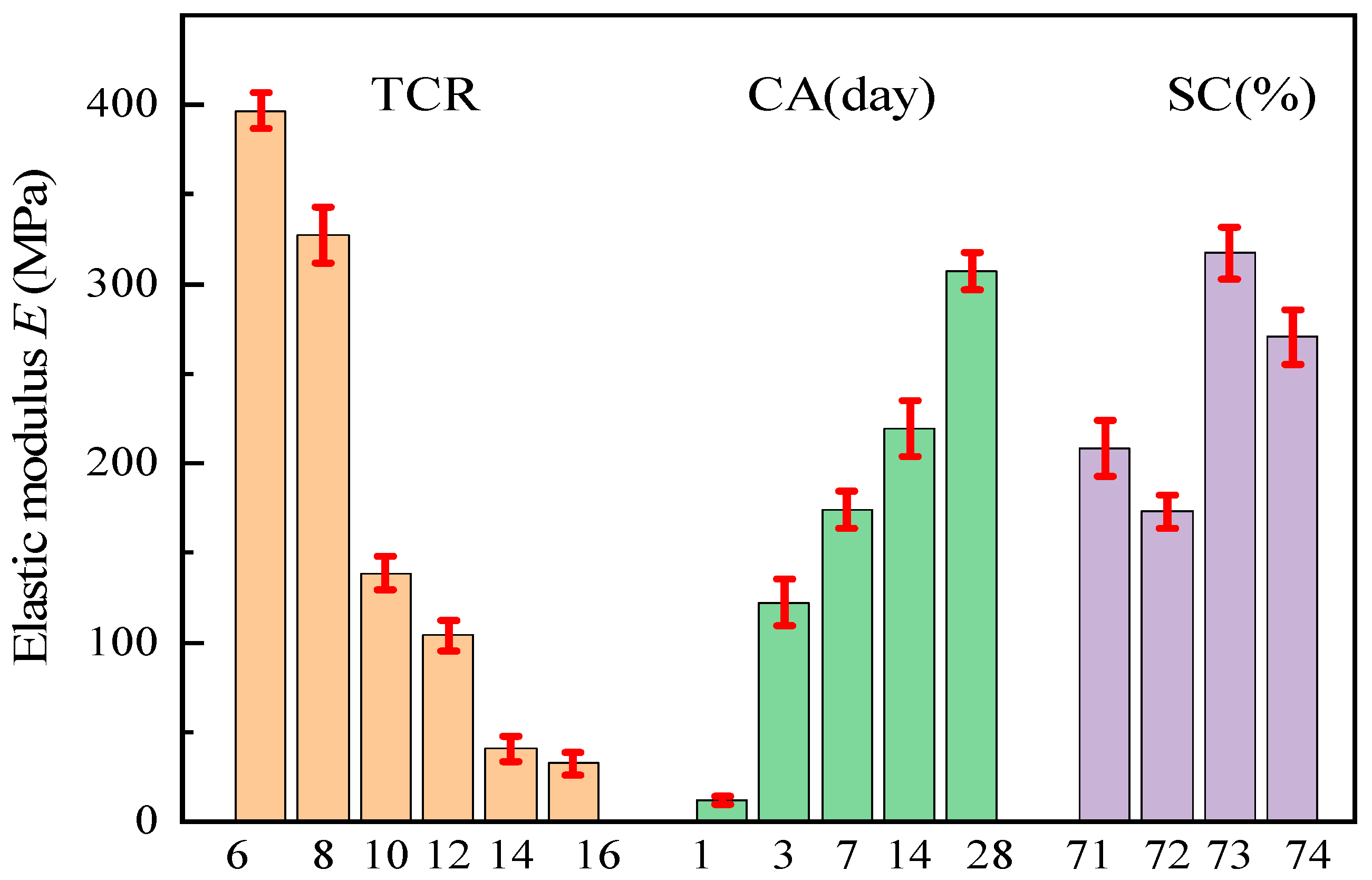
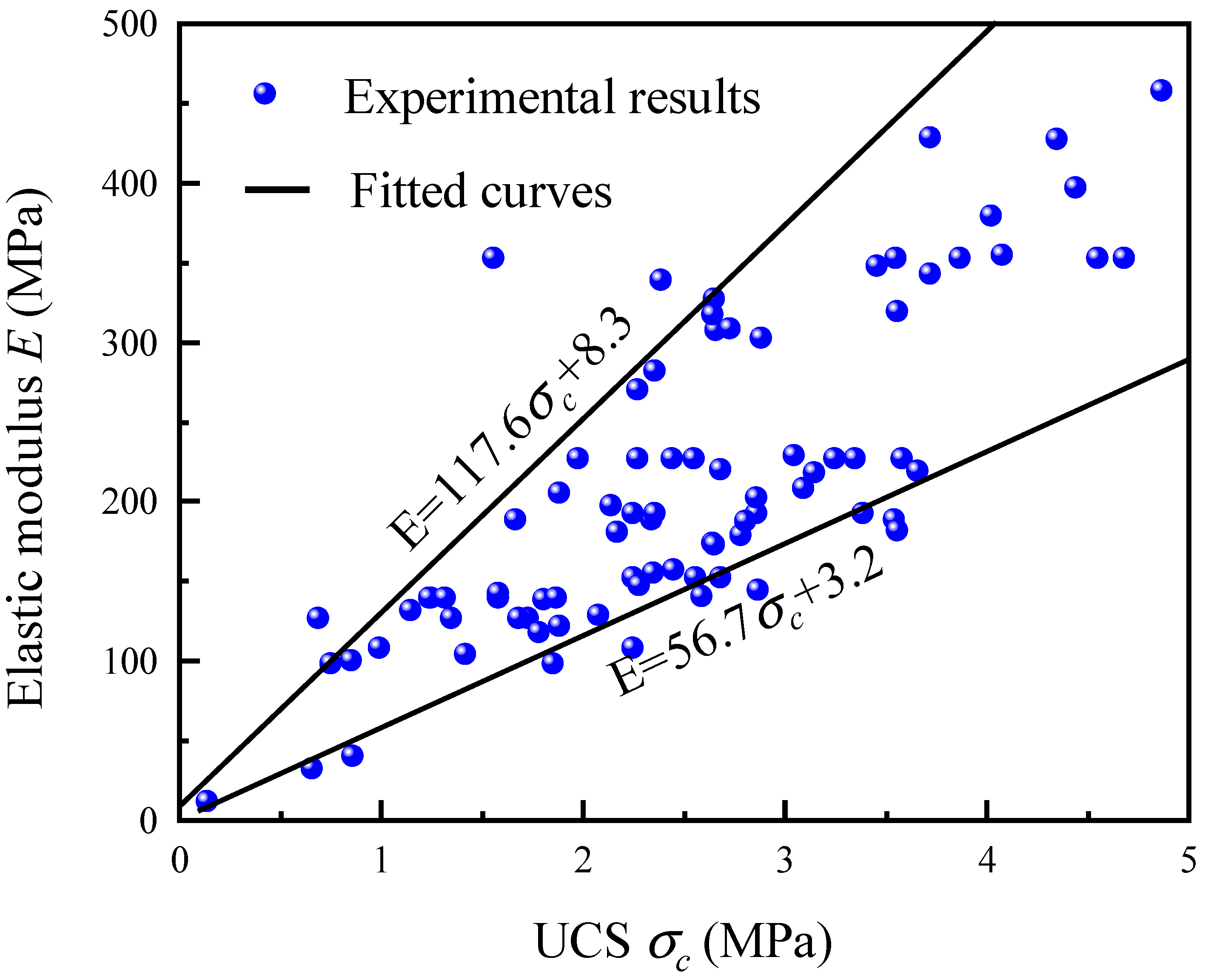
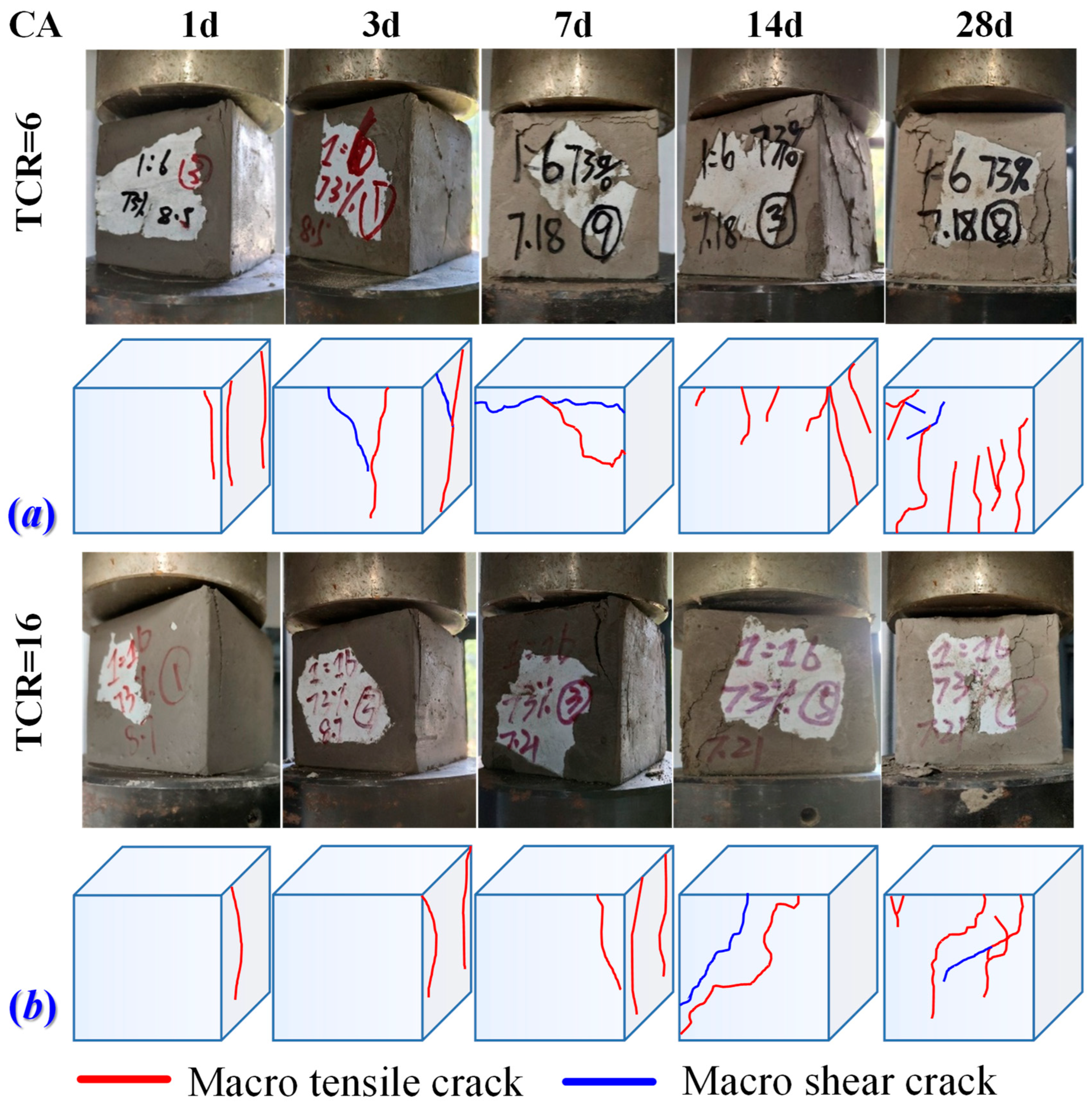
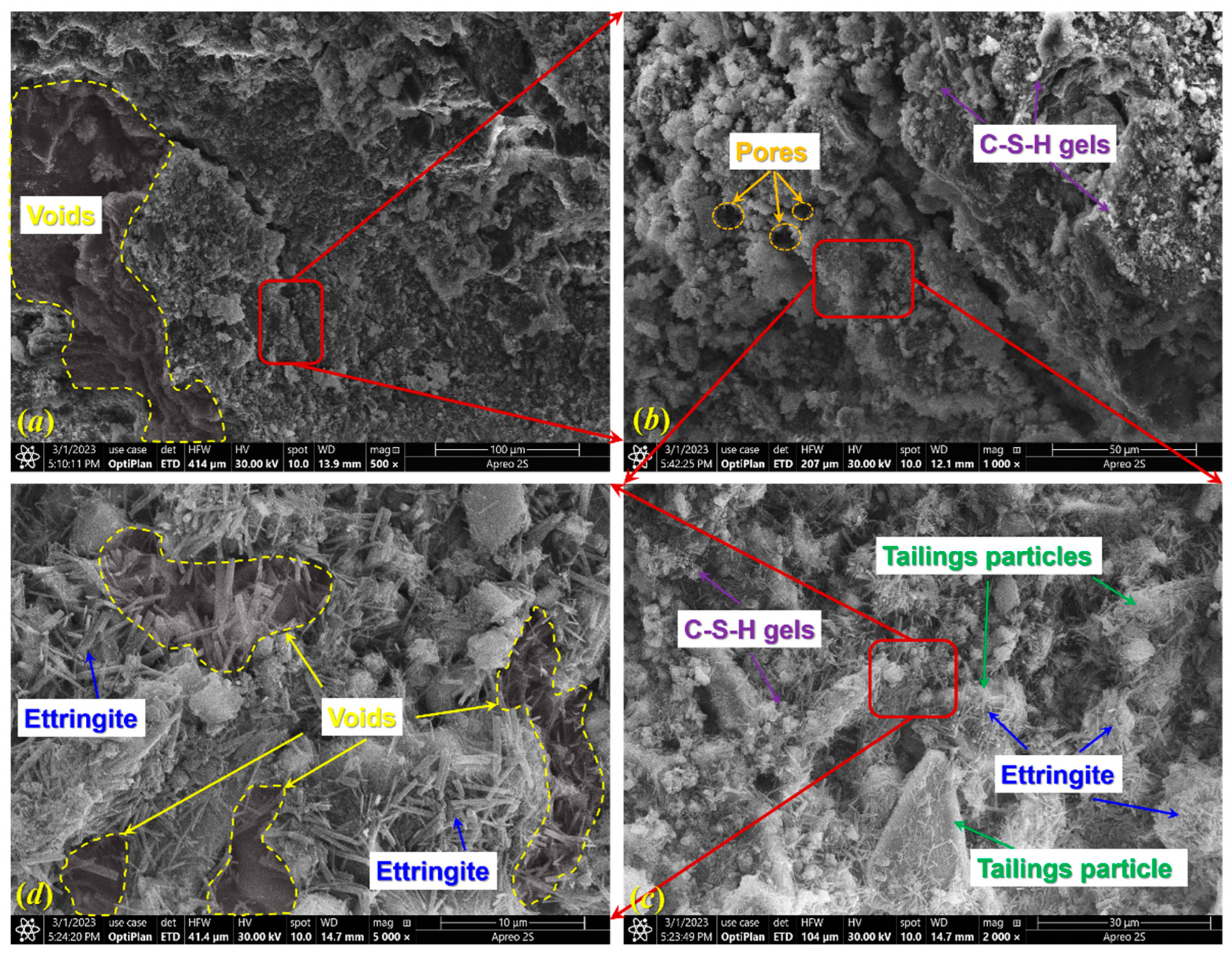

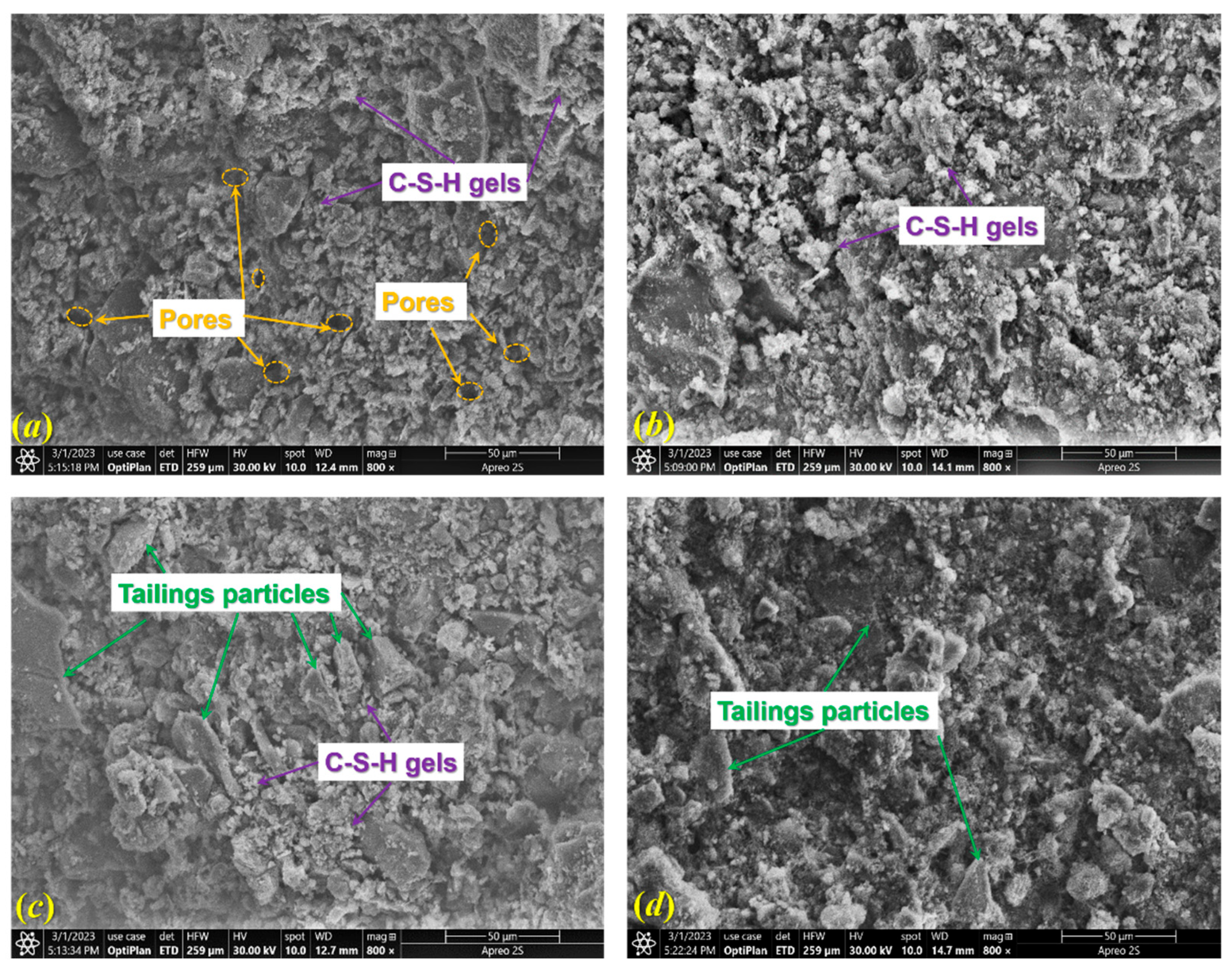
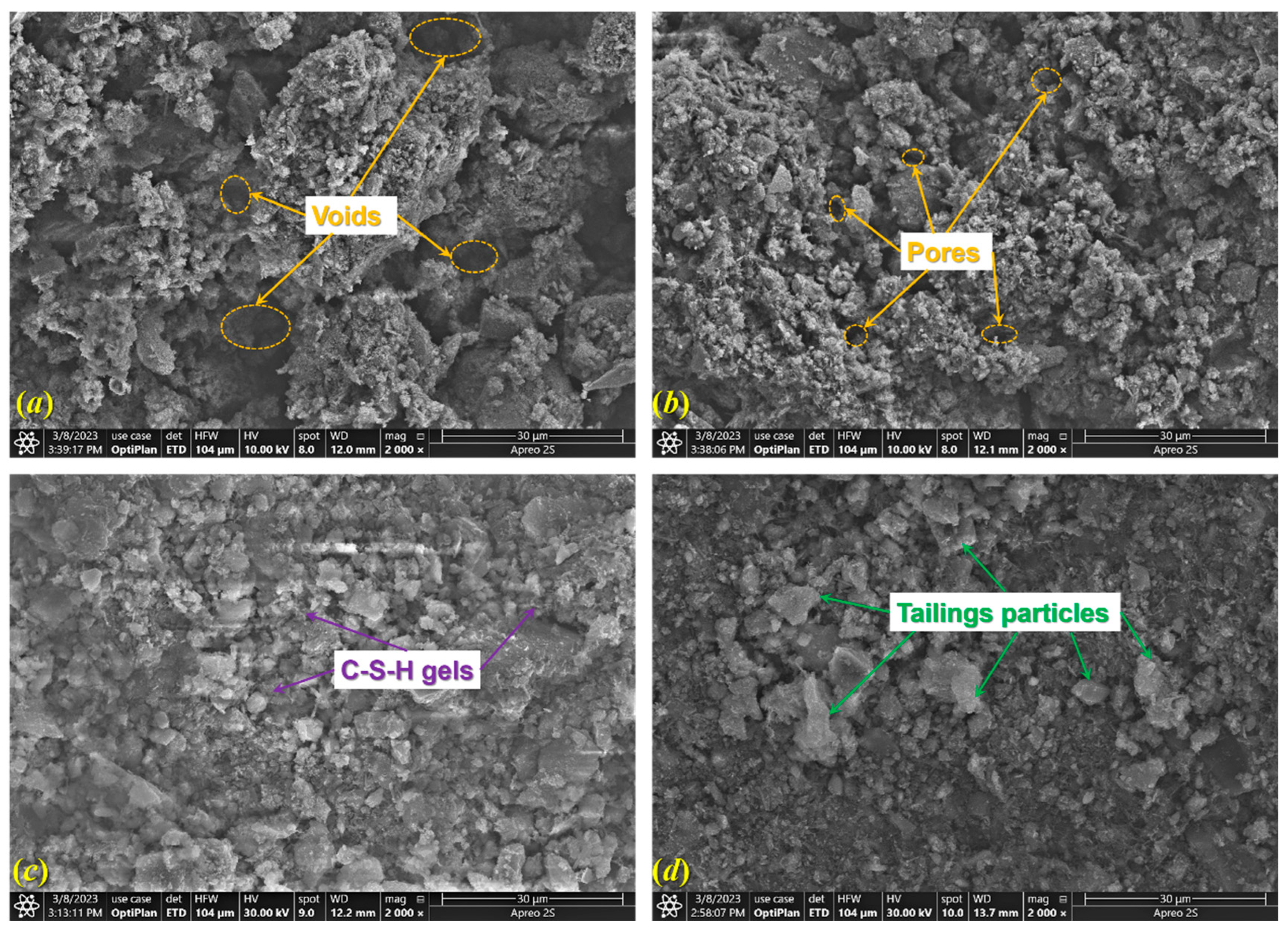
| Key Indicators | Gs | d10 (μm) | d30 (μm) | d50 (μm) | d60 (μm) | Cu | Cc |
|---|---|---|---|---|---|---|---|
| FT | 2.6 | 1.1 | 4.6 | 10.2 | 14.3 | 12.53 | 1.31 |
| Composition | CaSO4 | CaO | CaSiO3 | MgCO3 | SiO2 | ZnS | FeS2 | Ca(OH)2 | Al2O3 |
|---|---|---|---|---|---|---|---|---|---|
| FT (wt.%) | 5.3 | 7.8 | - | 3.8 | 64.9 | - | 7.8 | - | 7.1 |
| CP (wt.%) | 60.5 | 13.1 | 7.1 | 7.0 | 4.4 | 2.7 | - | 2.6 | - |
| Mechanical Testing | SC (wt. %) | TCR | CA (Day) |
|---|---|---|---|
| Uniaxial compressive test | 71, 72, 73, 74 | 6, 8, 10, 12, 14, 16 | 1, 3, 7, 14, 28 |
| Micro scanning test | 71, 72, 73, 74 | 6, 8, 12 | 3, 7, 14, 28 |
Disclaimer/Publisher’s Note: The statements, opinions and data contained in all publications are solely those of the individual author(s) and contributor(s) and not of MDPI and/or the editor(s). MDPI and/or the editor(s) disclaim responsibility for any injury to people or property resulting from any ideas, methods, instructions or products referred to in the content. |
© 2025 by the authors. Licensee MDPI, Basel, Switzerland. This article is an open access article distributed under the terms and conditions of the Creative Commons Attribution (CC BY) license (https://creativecommons.org/licenses/by/4.0/).
Share and Cite
Zhang, H.; Zhang, X.; Yan, L.; Xie, C.; Zhu, Z.; Chen, S.; Jiang, X. The Mechanical Properties and Microstructural Characterization of Copper Tailing Backfill Cemented with a Slag-Based Material. Buildings 2025, 15, 4004. https://doi.org/10.3390/buildings15214004
Zhang H, Zhang X, Yan L, Xie C, Zhu Z, Chen S, Jiang X. The Mechanical Properties and Microstructural Characterization of Copper Tailing Backfill Cemented with a Slag-Based Material. Buildings. 2025; 15(21):4004. https://doi.org/10.3390/buildings15214004
Chicago/Turabian StyleZhang, Haina, Xiutao Zhang, Lingsheng Yan, Changsheng Xie, Zewen Zhu, Shunman Chen, and Xinyue Jiang. 2025. "The Mechanical Properties and Microstructural Characterization of Copper Tailing Backfill Cemented with a Slag-Based Material" Buildings 15, no. 21: 4004. https://doi.org/10.3390/buildings15214004
APA StyleZhang, H., Zhang, X., Yan, L., Xie, C., Zhu, Z., Chen, S., & Jiang, X. (2025). The Mechanical Properties and Microstructural Characterization of Copper Tailing Backfill Cemented with a Slag-Based Material. Buildings, 15(21), 4004. https://doi.org/10.3390/buildings15214004





